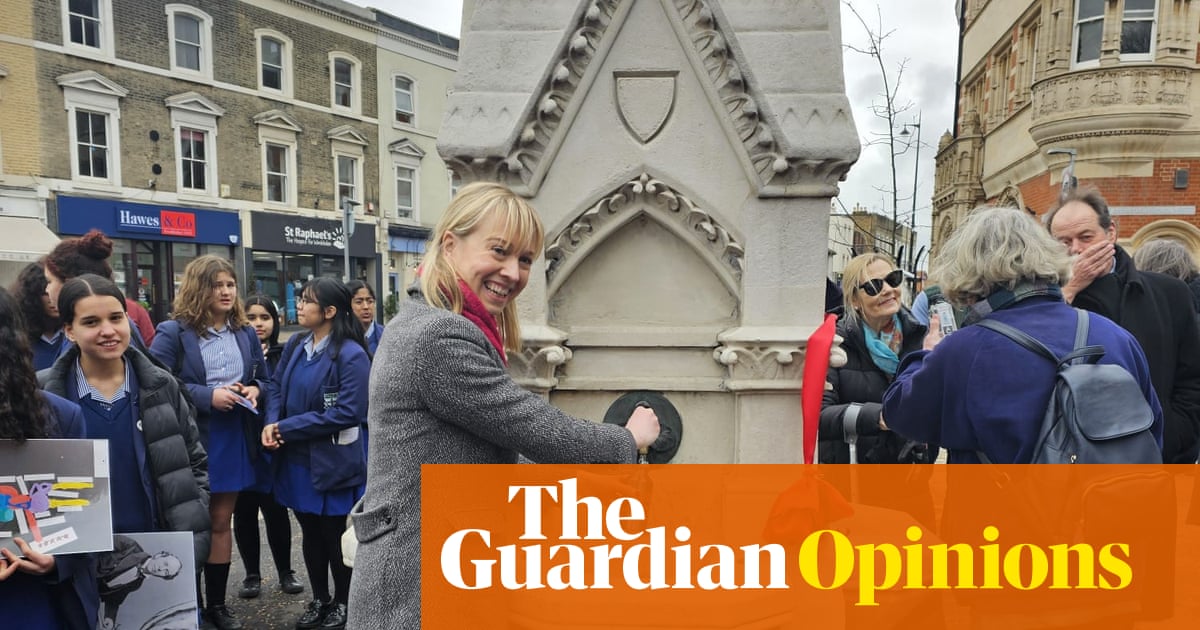
Enough contemplation of this government’s misdeeds: today I thought I’d take a break from rogue prime ministers and cabinets, a breather from their damage to the public realm. Instead, to enjoy a miniature item of good news, I attended the re-opening of a beautiful Victorian gothic water fountain in Wimbledon, south-west London, that has just been restored. Its ribbon was cut by local children involved in its current purpose: to urge people not to buy plastic water bottles but to refill their own bottles here.
I was there because the fountain was erected in 1868 in memory of my great-great-grandfather, Joseph Toynbee, otologist and ear-syringer to Queen Victoria: he died young in his laboratory experimenting on himself with chloroform for tinnitus. He was a radical local campaigner who fought to save Wimbledon Common from the rapacious Earl Spencer’s attempt to privatise and enclose it. He set up the Wimbledon Village Club, a working men’s institute for edification, entertainment, refreshments and a library, in much community use now. Family history records that his rigorous selflessness included dragging his nine children across Wimbledon Common on Christmas Day to make them donate their Christmas dinner to a Travellers’ encampment. The plaque on the fountain says that working men of Wimbledon and those “interested in the public good” paid for this memorial.
Once there were a thousand or more drinking fountains in London, and many more around the country, built from the 1860s onwards to provide clean piped water for those with access only to dirty public pumps, such as the one in Soho that was proven by John Snow to be the source of a cholera outbreak. Many beautiful and often eccentric drinking fountains were built by private subscription all over the country, but they fell into disrepair, with many demolished after the 1950s. You may pass one daily without noticing the neglected, water-less lump of stone.
The Drinking Fountain Association is trying to track each one around the country, and the Heritage of London Trust (Holt), with no public funds, is in the process of restoring 100 of them. Local authorities are far from cooperative, even when not asked to contribute, claiming health and safety concerns (this is the same water that is piped into homes) or cost (grants and local fundraising can do it: the Toynbee fountain restoration cost Holt £16,789, plus Thames Water’s reconnection charge.)
This is not just a fad for antiquarians. The point is to make refilling water bottles the norm and throw-away plastic unthinkable. Fountains work: when the St Paul’s recreation ground fountain in Brentford was restored a year ago, engaging local children, 94% of park users drank and refilled from it, with 55% saying it had stopped them from using plastic bottles. Fountains attract children who press in vain on long dead taps: restoration is an anti-plastic education campaign.
The average Londoner buys three plastic water bottles a week, with 7.7bn bottles bought nationally each year, creating mountains of plastic waste that takes 20 to 500 years to decompose. The City to Sea campaign estimates that if one in 10 people refilled just once a week, it would save 340m plastic bottles a year. Horrifying evidence grows of harm to the sea, wildlife – and us. Seabirds have just been diagnosed with a new disease, plasticosis, which destroys their digestive tracts, with chicks fed plastic pollution by parents accidentally. Humans, along the food chain, ingest an average 5 grams of plastic a week, the equivalent of eating a credit card. The US and UK are the world’s highest plastic waste producers per person, and Coca-Cola is one of the worst offenders, despite the company sponsoring the Cop27 climate summit.
The climate crisis can look dauntingly colossal, but the plastic disaster is easier to solve and the two are closely related. Plastic, made from fossil fuels, not only causes millions of metric tonnes of greenhouse gas emissions a year, but consumes vast quantities of water in a drought-stricken world. It takes 5.3 litres of water to produce a typical single-use water bottle. After Europe’s driest summer in 500 years, with much of the continent suffering a winter drought, what better time to ban pointless plastic?
Stand in a supermarket and survey the sea of packaging: in this intensely competitive market, consumer pressure could force an end to it. Though we diligently consign plastics to the right bins, less than 10% of the UK’s household plastic packaging is recycled; most goes to landfill or litter. How easily the EU banned some of the polluting plastics in 2021; the UK will follow later this year but will only meet the very minimum standards. Deposit return schemes are not difficult. What could be a simpler start than banning all plastic packaging from five fruits and vegetables – potatoes, apples, bananas, carrots and onions – as called for in petition by the campaigns City to Sea and Everyday Plastic.
Yet this government ducks these easiest steps. London’s mayor has set up 100 fine new blue drinking fountains, with many more cafes offering free water. But, says Holt, the mayor’s new ones cost more than restoring water to old monuments. If you have a derelict fountain nearby, a small but powerful gesture to alert neighbourhoods against plastic bottles is to campaign and fundraise to reopen these monuments to public spirit.
So yes, I ended up back here again, on plastic pollution as on everything else, contemplating this government’s perpetual failure to do the right thing.
Polly Toynbee is a Guardian columnist. Her memoir An Uneasy Inheritance: My Family and Other Radicals is published in June












